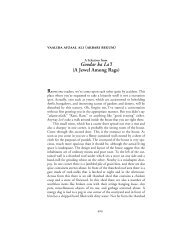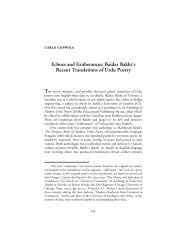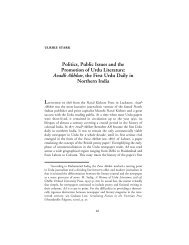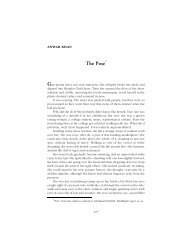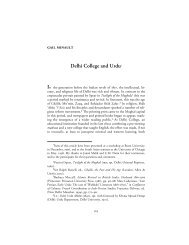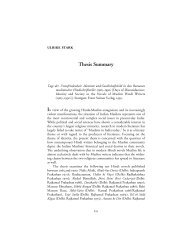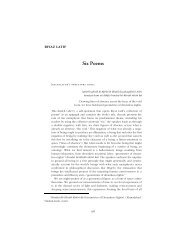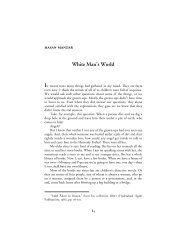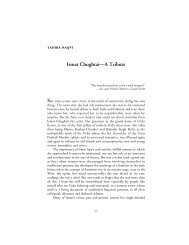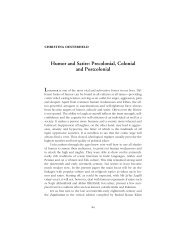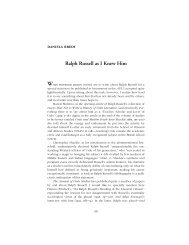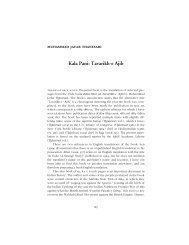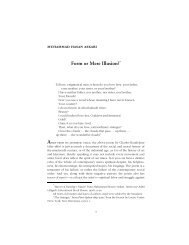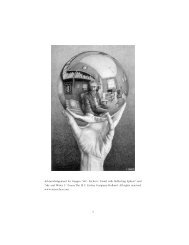The Sky, the Road, the Glass of Wine - the Annual of Urdu Studies
The Sky, the Road, the Glass of Wine - the Annual of Urdu Studies
The Sky, the Road, the Glass of Wine - the Annual of Urdu Studies
Create successful ePaper yourself
Turn your PDF publications into a flip-book with our unique Google optimized e-Paper software.
frances w. pritchett<br />
<strong>The</strong> <strong>Sky</strong>, <strong>the</strong> <strong>Road</strong>, <strong>the</strong> <strong>Glass</strong> <strong>of</strong> <strong>Wine</strong>:<br />
On Translating Faiz<br />
Many <strong>of</strong> us have tried to translate <strong>Urdu</strong> poetry into English. In fact<br />
<strong>the</strong>re are more and more <strong>of</strong> us nowadays, which is an encouraging sign<br />
for <strong>the</strong> future. But <strong>the</strong>re are all too few chances for mutual discussion or<br />
for learning from each o<strong>the</strong>r’s experiences. I want to suggest some thinking<br />
points for us all—what can (and can’t) we reasonably expect to<br />
achieve in a translation? What kind <strong>of</strong> problems are solvable, and what<br />
kind are probably not?<br />
My own experience started with a great desire to translate classical<br />
<strong>Urdu</strong> ghazal. I was always looking around for clues to how it could be<br />
done. <strong>The</strong> search was a frustrating one, but I was young, naïve, and<br />
hopeful. For various reasons, I did not like most <strong>of</strong> <strong>the</strong> translations that I<br />
saw. But could I do any better myself? I was not interested in making<br />
technically accurate translations that sounded awful in English and/or did<br />
no real justice to <strong>the</strong> original. Nor was I interested in producing free<br />
“transcreations” that used <strong>the</strong> <strong>Urdu</strong> originals merely as jumping-<strong>of</strong>f<br />
points for new English poems. I read some translation <strong>the</strong>ory, but I found<br />
that it tended to be ei<strong>the</strong>r extremely abstract and philosophical, or else<br />
grounded on specific successes in o<strong>the</strong>r languages that were not easy to<br />
emulate in <strong>Urdu</strong>. If practical advice was <strong>of</strong>fered, it was <strong>of</strong>ten just<br />
common-sensical (<strong>the</strong> translator was urged, for example, to respond to<br />
<strong>the</strong> needs <strong>of</strong> <strong>the</strong> intended audience).<br />
So I began to think about <strong>the</strong> whole process in quite concrete terms.<br />
Naturally (to me at least), I began by asking myself what sort <strong>of</strong> features<br />
<strong>of</strong> a poem were more “translatable” than o<strong>the</strong>rs. One obvious choice:<br />
formal features that could be replicated in English. And <strong>of</strong> all such formal<br />
features, repetition was surely <strong>the</strong> easiest and <strong>the</strong> least problematical. So,<br />
since I wanted above all to work on Gh≥lib, I began to look for ways I<br />
57
58 • <strong>The</strong> <strong>Annual</strong> <strong>of</strong> <strong>Urdu</strong> <strong>Studies</strong><br />
could translate ghazals and preserve <strong>the</strong> radµf. Some ghazals obviously had<br />
eminently preservable radµfs: Mµr’s “mai nash® m® h∑ ,” for example, or<br />
Måmin’s “tum^® y≥d hå ke na y≥d hå,” or Gh≥lib’s “jal gay≥ ” or “mauj-e<br />
shar≥b.” In a few such cases, I thought I had some limited success. 1 But<br />
most ghazals, <strong>of</strong> course, had unpreservable radµfs, or sometimes none at<br />
all. And <strong>the</strong> fur<strong>the</strong>r difficulties <strong>of</strong> multivalent “meaning-creation” (ma‘nµ<br />
≥frµnµ) and wordplay kept thwarting my best efforts to translate Gh≥lib,<br />
<strong>the</strong> “difficult” poet, <strong>the</strong> one on whom my heart was set.<br />
When I looked at modern poets, however, I felt a bit more hopeful.<br />
Since modern <strong>Urdu</strong> poets so <strong>of</strong>ten make a point <strong>of</strong> avoiding <strong>the</strong> traditional<br />
kinds <strong>of</strong> complex wordplay, multivalent meanings, subtle allusions,<br />
and so on, <strong>the</strong>re tends to be less to lose: starkness, simplicity, deliberate<br />
prosiness, colloquial language seem to travel so much better across <strong>the</strong><br />
language barrier. Moreover, na ms as a genre travel better than ghazals,<br />
since <strong>the</strong>y usually operate in units <strong>of</strong> thought larger than <strong>the</strong> two-line<br />
she‘r, and create <strong>the</strong>ir own contexts ra<strong>the</strong>r than requiring <strong>the</strong> reader to<br />
bring and use so much prior knowledge <strong>of</strong> <strong>the</strong> tradition. Thus even when<br />
modern na ms are complex and subtle (as <strong>the</strong> best ones <strong>of</strong>ten are), <strong>the</strong>y<br />
tend to require less background on <strong>the</strong> part <strong>of</strong> <strong>the</strong> reader. <strong>The</strong> result has<br />
been that <strong>the</strong> poetry I’ve translated 2 has mostly been modern, and has<br />
mostly consisted <strong>of</strong> na ms.<br />
*<br />
Of all modern poets, in practice <strong>the</strong> inescapable, indispensable one is Fai¤.<br />
He is generally perceived as <strong>the</strong> hinge between <strong>the</strong> classical and modern<br />
ghazal; he is widely known, loved, and even revered. Compared to his<br />
great contemporaries N∑n Mµm R≥shid and Mµr≥jµ, he has been by far <strong>the</strong><br />
most amply translated: at least five translators have produced whole<br />
English volumes <strong>of</strong> his work, and he appears in countless anthologies.<br />
Partly because <strong>of</strong> this lavish and <strong>of</strong>ten high-quality set <strong>of</strong> translations, I<br />
never added my own two cents, though I have studied and taught Fai¤’s<br />
poetry for years.<br />
I first came to know Fai¤ through Victor Kiernan’s very helpful book<br />
1 Some <strong>of</strong> <strong>the</strong>se were published as “Two Ghazals” and “Stanzas from Ghalib”<br />
in New Letters 51. 4 (Summer, 1985): 126–30.<br />
2 A Listening Game: Poems by Saqi Farooqi (London: Lokamaya Publications,<br />
1987) and, with Asif Aslam, An Evening <strong>of</strong> Caged Beasts: Seven Post-Modernist<br />
<strong>Urdu</strong> Poets (Karachi: Oxford University Press, 1998).
Frances W. Pritchett • 59<br />
(which is now long out <strong>of</strong> print, alas, though I am trying to get it<br />
reprinted). Of all <strong>the</strong> poems Kiernan included, my eye fell on one in<br />
particular that seemed born for translation. What a pleasure it was to read<br />
it and think how <strong>the</strong> translation might be done! Here is <strong>the</strong> poem that<br />
seemed to me so relatively translatable:<br />
Ra g hai Dil k≥ Mir®<br />
(1) Tum na ≥’® t^® tå har ±µz vahµ t^µ ke jå hai<br />
(2) ¥sm≥ √add-e na ar, r≥h guÿar r≥h guÿar, shµsha-e ma’® shµsha-e ma’®<br />
(3) Aur ab shµsha-e ma’®, r≥h guÿar, ra g-e falak<br />
(4) Ra g hai dil k≥ mir®, “kh∑n-e jigar hån® tak”<br />
(5) ≤ampa’µ ra g kab^µ r≥√at-e dµd≥r k≥ ra g<br />
(6) Surma’µ ra g ke hai s≥‘at-e b®z≥r k≥ ra g<br />
(7) Zard pattå k≥, khas-o-kh≥r k≥ ra g<br />
(8) Surkh p^∑lå k≥ dahakt® h∑’® gulz≥r k≥ ra g<br />
(9) Zahr k≥ ra g, lah∑ ra g, shab-e t≥r k≥ ra g<br />
(10) ¥sm≥ , r≥h guÿar, shµsha-e ma’®<br />
(11) Kå’µ b^µg≥ h∑’≥ d≥man, kå’µ duk^tµ h∑’µ rag<br />
(12) Kå’µ har la√ a badalt≥ h∑’≥ ≥’µna hai<br />
(13) Ab jå ≥’® hå tå ª^ahrå ke kå’µ ra g, kå’µ rut, kå’µ shai<br />
(14) ‡k jagah par ª^ahr®,<br />
(15) P^ir s® ik b≥r har ik ±µz vahµ hå jå hai<br />
(16) ¥sm≥ √add-e na ar, r≥h guÿar r≥h guÿar, shµsha-e ma’® shµsha-e ma’®<br />
For purposes <strong>of</strong> discussion, I give <strong>the</strong> poem here in <strong>the</strong> definitive<br />
form in which it appears in Fai¤ A√mad Fai¤’s kulliy≥t, Nuskhah≥-e Vaf≥,<br />
with spacing and punctuation exactly as in <strong>the</strong> <strong>Urdu</strong>. 3<br />
I was encouraged by <strong>the</strong> very marked formal structure <strong>of</strong> <strong>the</strong> poem;<br />
anyone who looks at <strong>the</strong> <strong>Urdu</strong> will surely see it immediately. Most<br />
obviously, line (2) and line (16)—<strong>the</strong> final line—are exactly <strong>the</strong> same, and<br />
each consists <strong>of</strong> triple pairs: “sky limit-<strong>of</strong>-sight, road road, glass <strong>of</strong> wine<br />
glass <strong>of</strong> wine.” Within <strong>the</strong> poem, moreover, <strong>the</strong>se three pairs form basic<br />
organizational elements. Line (3) alludes to <strong>the</strong>m in reverse order (altering<br />
one for <strong>the</strong> sake <strong>of</strong> a crucial rhyme), and line (4) links <strong>the</strong>m to <strong>the</strong> title <strong>of</strong><br />
<strong>the</strong> poem. Line (10) repeats <strong>the</strong>m yet again, and lines (11) and (12)<br />
implicitly turn sky, road, and glass <strong>of</strong> wine into a wet garment-hem, an<br />
aching vein, and a mirror changing every moment. Thus by <strong>the</strong> time <strong>the</strong>y<br />
3 (Delhi: Educational Publishing House, 1986), pp. 365–6.
60 • <strong>The</strong> <strong>Annual</strong> <strong>of</strong> <strong>Urdu</strong> <strong>Studies</strong><br />
are so starkly repeated in <strong>the</strong> last line, <strong>the</strong> trinity <strong>of</strong> sky, road, and glass <strong>of</strong><br />
wine have formed an evocative, if deliberately elliptical, framework for <strong>the</strong><br />
poem. I felt that <strong>the</strong>y were a gift from God (or Fai¤ ) to <strong>the</strong> translator.<br />
Here are <strong>the</strong> first lines and <strong>the</strong> last lines <strong>of</strong> four translations <strong>of</strong> this<br />
poem. I am going to label <strong>the</strong>m A through D, in chronological order; <strong>the</strong><br />
key will be found in <strong>the</strong> Appendix.<br />
(A) Before you came, all things were what <strong>the</strong>y are—<br />
<strong>The</strong> sky sight’s boundary, <strong>the</strong> road a road,<br />
<strong>The</strong> glass <strong>of</strong> wine a glass <strong>of</strong> wine;<br />
...<br />
And all things once again be <strong>the</strong>ir own selves,<br />
<strong>The</strong> sky sight’s bound, <strong>the</strong> road a road, wine wine.<br />
(B) Before you came things were just what <strong>the</strong>y were:<br />
<strong>the</strong> road precisely a road, <strong>the</strong> horizon fixed,<br />
<strong>the</strong> limit <strong>of</strong> what could be seen,<br />
a glass <strong>of</strong> wine was no more than a glass <strong>of</strong> wine.<br />
...<br />
This time things will fall into place;<br />
<strong>the</strong> road can be <strong>the</strong> road,<br />
<strong>the</strong> sky nothing but sky;<br />
<strong>the</strong> glass <strong>of</strong> wine, as it should be, <strong>the</strong> glass <strong>of</strong> wine.<br />
(C) Before you came,<br />
things were as <strong>the</strong>y should be:<br />
<strong>the</strong> sky was <strong>the</strong> dead-end <strong>of</strong> sight,<br />
<strong>the</strong> road was just a road, wine merely wine.<br />
...<br />
Stay. So <strong>the</strong> world may become like itself again:<br />
so <strong>the</strong> sky may be <strong>the</strong> sky,<br />
<strong>the</strong> road a road,<br />
and <strong>the</strong> glass <strong>of</strong> wine not a mirror, just a glass <strong>of</strong> wine.<br />
(D) Before you came, everything was what it is—<br />
<strong>the</strong> sky, vision-bound<br />
<strong>the</strong> pathway, <strong>the</strong> wine-glass.<br />
...<br />
and once again everything may become what it was—<br />
<strong>the</strong> sky, vision-bound, <strong>the</strong> pathway, <strong>the</strong> wine-glass.<br />
It is not hard to see that each <strong>of</strong> <strong>the</strong>se translations obscures Fai¤’s
Frances W. Pritchett • 61<br />
careful structure <strong>of</strong> elegant, slightly oblique, paired repetitions. Though<br />
(A) preserves strong similarities, only in (D) can <strong>the</strong> reader guess that <strong>the</strong><br />
second and final lines <strong>of</strong> <strong>the</strong> original might be totally identical—and (D)<br />
doesn’t reflect Fai¤’s repetition <strong>of</strong> <strong>the</strong> three items at all. Moreover, (D) has<br />
<strong>the</strong> problem that “vision-bound” is most naturally read in English as<br />
“bound by vision” or “bound for vision” ra<strong>the</strong>r than “<strong>the</strong> boundary <strong>of</strong><br />
vision.” Both (B) and (C) introduce a moralizing note: (B) speaks <strong>of</strong> “<strong>the</strong><br />
glass <strong>of</strong> wine, as it should be, <strong>the</strong> glass <strong>of</strong> wine,” and (C) <strong>of</strong> how “things<br />
were as <strong>the</strong>y should be”; <strong>the</strong> <strong>Urdu</strong> <strong>of</strong>fers no hint <strong>of</strong> any such “oughtness.”<br />
Thus <strong>the</strong> translators ei<strong>the</strong>r overlook or consciously ignore <strong>the</strong> very<br />
marked, and conspicuously translatable, formal structure that Fai¤ has<br />
given to <strong>the</strong> poem.<br />
*<br />
Fai¤’s careful—and carefully unexplained—set <strong>of</strong> correspondences in lines<br />
10–12 suffers <strong>the</strong> same kind <strong>of</strong> damage. Loosely linking his trinity <strong>of</strong><br />
items, as a group, to a second set <strong>of</strong> three items, Fai¤ says:<br />
(10) ¥sm≥ , r≥h guÿar, shµsha-e ma’®<br />
(11) Kå’µ b^µg≥ h∑’≥ d≥man, kå’µ duk^tµ h∑’µ rag<br />
(12) Kå’µ har la√ a badalt≥ h∑’≥ ≥’µna hai<br />
<strong>Sky</strong>, road, glass <strong>of</strong> wine<br />
is some wet garment-hem, some aching vein,<br />
some mirror changing every moment<br />
Here is how <strong>the</strong> translators deal with it:<br />
(A) <strong>Sky</strong>, highroad, glass <strong>of</strong> wine—<br />
<strong>The</strong> first a tear-stained robe, <strong>the</strong> next a nerve<br />
Aching, <strong>the</strong> last a mirror momently altering....<br />
(B) As for <strong>the</strong> sky, <strong>the</strong> road, <strong>the</strong> cup <strong>of</strong> wine:<br />
one was my tear-drenched shirt,<br />
<strong>the</strong> o<strong>the</strong>r an aching nerve,<br />
<strong>the</strong> third a mirror that never reflected <strong>the</strong> same thing.<br />
(C) And <strong>the</strong> sky, <strong>the</strong> road, <strong>the</strong> glass <strong>of</strong> wine?<br />
<strong>The</strong> sky is a shirt wet with tears,<br />
<strong>the</strong> road a vein about to break,<br />
and <strong>the</strong> glass <strong>of</strong> wine a mirror in which
62 • <strong>The</strong> <strong>Annual</strong> <strong>of</strong> <strong>Urdu</strong> <strong>Studies</strong><br />
<strong>the</strong> sky, <strong>the</strong> road, <strong>the</strong> world keep changing.<br />
(D) <strong>The</strong> sky, <strong>the</strong> pathway, <strong>the</strong> wine-glass—<br />
some tear-stained robe, some wincing nerve,<br />
some ever-revolving mirror.<br />
Since <strong>the</strong> translators do not take care to preserve <strong>the</strong> unmediated<br />
exact repetitions <strong>of</strong> <strong>the</strong>se three crucial items throughout <strong>the</strong> poem, <strong>the</strong>y<br />
cannot get <strong>the</strong> maximum effect from a passage like this. (D) is <strong>the</strong> closest<br />
to <strong>the</strong> <strong>Urdu</strong>, though “wincing” is a facial expression and thus applies to<br />
people ra<strong>the</strong>r than nerves, “ever-revolving mirror” sounds like a lighthouse<br />
fixture ra<strong>the</strong>r than a mirror that actually “changes” at every<br />
moment (as does <strong>the</strong> surface <strong>of</strong> a glass <strong>of</strong> wine), and “wine-glass” could<br />
easily be an empty glass, ra<strong>the</strong>r than a full one such as would create a<br />
mirror in its liquid surface.<br />
Apart from (D), <strong>the</strong> o<strong>the</strong>r three all feel <strong>the</strong> need to give <strong>the</strong> reader<br />
extra prompting: (A) through explaining that <strong>the</strong> “first” is one thing, <strong>the</strong><br />
“next” ano<strong>the</strong>r; (B) through enumerating “one,” “<strong>the</strong> o<strong>the</strong>r,” and “<strong>the</strong><br />
third”; (C) through actually making <strong>the</strong> identifications explicit (“<strong>The</strong> sky<br />
is...” and so on). <strong>The</strong>y thus link <strong>the</strong> three items to <strong>the</strong>ir three metaphorical<br />
counterparts in a flatter, more pedestrian way than Fai¤ does. It is easy<br />
to imagine <strong>the</strong>ir reason for doing so: it might not be entirely evident to<br />
<strong>the</strong> reader that <strong>the</strong>se three new items were meant to correspond one-forone<br />
to <strong>the</strong> three items in <strong>the</strong> line before, so it would be better to clarify it<br />
a bit.<br />
Yet this whole “clarification” process, it seems to me, is a fix for a<br />
problem that could have been avoided in <strong>the</strong> first place. Fai¤ has set up a<br />
structure in his <strong>Urdu</strong> poem that cues any reasonably alert reader to make<br />
exactly <strong>the</strong>se identifications. It is no harder for <strong>the</strong> reader to do this kind<br />
<strong>of</strong> thing in English than to do it in <strong>Urdu</strong>; English poets routinely expect<br />
much more difficult feats than this from <strong>the</strong>ir readers. No special cultural<br />
background or baggage is involved here—only a genuine, close attentiveness<br />
to <strong>the</strong> language <strong>of</strong> <strong>the</strong> poem as it develops. Only because <strong>the</strong> translators<br />
have not reproduced Fai¤’s careful and systematic formal structure in<br />
English, although <strong>the</strong>y easily could have, do <strong>the</strong>y have to insert artificial<br />
clues and “helps” for <strong>the</strong>ir readers—and thus in every case make <strong>the</strong> poem<br />
simpler and more prosy, less fluid and mysterious, than <strong>the</strong> original.<br />
*<br />
<strong>The</strong>re are legitimate problems too, <strong>of</strong> course, that <strong>the</strong> translators
Frances W. Pritchett • 63<br />
face—problems that cannot be resolved merely by replicating a formal<br />
structure. One such problem is <strong>the</strong> translation <strong>of</strong> “b^µg≥ h∑’≥ d≥man.” No<br />
doubt <strong>the</strong> sense <strong>of</strong> “d≥man” as “garment-hem,” meaning something like<br />
<strong>the</strong> trailing edge <strong>of</strong> a long robe, is clumsy to express in English, and <strong>the</strong><br />
classical Persian-<strong>Urdu</strong> idiom <strong>of</strong> a “wet garment-hem” as a sign <strong>of</strong><br />
pollution or sinfulness (cf. tar-d≥manµ vs. p≥k-d≥manµ) does not really<br />
come through in English very well. All <strong>the</strong> translators seem to have<br />
decided, however, that <strong>the</strong> wetness on <strong>the</strong> garment-hem is that <strong>of</strong> tears. I<br />
don’t know <strong>of</strong> any reason in <strong>the</strong> <strong>Urdu</strong> to make such an explicit<br />
identification.<br />
If anything, to see <strong>the</strong> sky as a dirty, stained, bedraggled garmen<strong>the</strong>m,<br />
a garment that has been trailing in <strong>the</strong> mud, a sign <strong>of</strong> sin and pollution,<br />
seems much more in keeping with Fai¤’s poem. After all, in <strong>the</strong><br />
poem <strong>the</strong>re are clear references to moods <strong>of</strong> exaltation, as well as blood<br />
and poison, and no references at all to tears—much less to <strong>the</strong> kind <strong>of</strong><br />
endless weeping that would drench a garment. In fact Fai¤ is not at all a<br />
lachrymose poet: when you think <strong>of</strong> <strong>the</strong> range <strong>of</strong> moods he describes in<br />
his poems, it is hard to come up with many examples <strong>of</strong> tears, and easy to<br />
find situations in which tears and grieving have been emphatically<br />
rejected in favor <strong>of</strong> more meditative or politically inspirational moods.<br />
Moreover, (B) has decided that <strong>the</strong> tear-wet garment is “my teardrenched<br />
shirt,” (C) describes it as “a shirt wet with tears”; <strong>the</strong>re’s no<br />
warrant in <strong>the</strong> poem, however, for turning <strong>the</strong> sky or a robe or a garmen<strong>the</strong>m<br />
into a “shirt,” much less “my” shirt. <strong>The</strong> sky, after all, is much more<br />
like a spread-out cloak or o<strong>the</strong>r long flowing garment, than it is like a<br />
shirt, so that <strong>the</strong> altered metaphor becomes much less effective. And since<br />
<strong>the</strong> lover’s tears in <strong>the</strong> ghazal world tend most <strong>of</strong>ten to be tears <strong>of</strong> blood,<br />
<strong>the</strong> vision <strong>of</strong> a possibly blood-drenched garment would rise involuntarily<br />
to <strong>the</strong> traditionally-trained reader’s eye. This association <strong>of</strong> ideas is<br />
ano<strong>the</strong>r reason Fai¤ is unlikely to have wanted us to think <strong>of</strong> <strong>the</strong> sky<br />
primarily as wet with (bloody) tears. Translations (B) and (C) have turned<br />
an image <strong>of</strong> cosmic bleakness—<strong>the</strong> sky as a stained, polluted cloak—into<br />
a piece <strong>of</strong> personal emotional expression—<strong>the</strong> sky as a shirt wet with tears<br />
(presumably shed by <strong>the</strong> wearer). In <strong>the</strong> process, <strong>the</strong>y have replaced Fai¤’s<br />
ambiguity—he pointedly does not tell us what <strong>the</strong> sky is wet with—with<br />
an explicit piece <strong>of</strong> (pseudo-)information.<br />
*<br />
If we look at <strong>the</strong> middle part <strong>of</strong> Fai¤’s poem, we see a separate movement<br />
<strong>of</strong> thought, one that involves <strong>the</strong> basic three items (sky, road, glass <strong>of</strong>
64 • <strong>The</strong> <strong>Annual</strong> <strong>of</strong> <strong>Urdu</strong> <strong>Studies</strong><br />
wine) in an intense play <strong>of</strong> colors:<br />
(3) Aur ab shµsha-e ma’®, r≥h guÿar, ra g-e falak<br />
(4) Ra g hai dil k≥ mir®, “kh∑n-e jigar hån® tak”<br />
(5) ≤ampa’µ ra g kab^µ r≥√at-e dµd≥r k≥ ra g<br />
(6) Surma’µ ra g ke hai s≥‘at-e b®z≥r k≥ ra g<br />
(7) Zard pattå k≥, khas-o-kh≥r k≥ ra g<br />
(8) Surkh p^∑lå k≥ dahakt® h∑’® gulz≥r k≥ ra g<br />
(9) Zahr k≥ ra g, lah∑ ra g, shab-e t≥r k≥ ra g<br />
In lines (5) through (9), we see that <strong>the</strong> word “ra g,” “color,” is<br />
repeated no fewer than nine times, three <strong>of</strong> <strong>the</strong>m in <strong>the</strong> final line. This<br />
repetition is almost as conspicuous and obtrusive in <strong>Urdu</strong> as it would be<br />
in English; it goes well beyond <strong>the</strong> creation <strong>of</strong> end-rhymes, and plainly<br />
represents a deliberate, emphatic effect that <strong>the</strong> poet is creating. Here is<br />
how <strong>the</strong> translators render lines (5) through (9):<br />
(A) Now golden, as <strong>the</strong> solace <strong>of</strong> meeting is,<br />
Now grey, <strong>the</strong> livery <strong>of</strong> despondent hours,<br />
Or tint <strong>of</strong> yellowed leaves, <strong>of</strong> garden trash,<br />
Or scarlet petal, a flowerbed all ablaze:<br />
Colour <strong>of</strong> poison, colour <strong>of</strong> blood, or shade<br />
Of sable night.<br />
(B) your eyes gold<br />
as <strong>the</strong>y open to me, slate <strong>the</strong> color<br />
that falls each time I lost all hope.<br />
With your advent roses burst into flame:<br />
you were <strong>the</strong> artist <strong>of</strong> dried-up leaves, sorceress<br />
who flicked her wrist to change dust into soot.<br />
You lacquered <strong>the</strong> night black.<br />
(C) <strong>the</strong> grey <strong>of</strong> your absence, <strong>the</strong> color <strong>of</strong> poison, or thorns,<br />
<strong>the</strong> gold when we meet, <strong>the</strong> season ablaze,<br />
<strong>the</strong> yellow <strong>of</strong> autumn, <strong>the</strong> red <strong>of</strong> flowers, <strong>of</strong> flames,<br />
and <strong>the</strong> black when you cover <strong>the</strong> earth<br />
with <strong>the</strong> coal <strong>of</strong> dead fires.<br />
(D) Sometimes <strong>the</strong> golden tinge, sometimes <strong>the</strong> hue <strong>of</strong> <strong>the</strong> joy <strong>of</strong> seeing<br />
you<br />
sometimes ashen, <strong>the</strong> shade <strong>of</strong> <strong>the</strong> dreary moment—
<strong>the</strong> colour <strong>of</strong> yellow leaves, <strong>of</strong> thorn and trash,<br />
<strong>of</strong> <strong>the</strong> crimson petals <strong>of</strong> <strong>the</strong> flower-beds aglow,<br />
<strong>the</strong> tint <strong>of</strong> poison, <strong>of</strong> blood, <strong>of</strong> sable night.<br />
Frances W. Pritchett • 65<br />
Even without a detailed discussion, it’s easy to see that all <strong>the</strong> translations<br />
have avoided Fai¤’s incantatory repetition <strong>of</strong> <strong>the</strong> word “color.”<br />
Perhaps <strong>the</strong> translators thought “color” in English could not be as<br />
evocative as “ra g” in <strong>Urdu</strong>? It is easy to sympathize with <strong>the</strong>m, and yet<br />
<strong>the</strong> attempt could have been an interesting one. It seems to me that <strong>the</strong><br />
translators didn’t trust <strong>the</strong> English-reading audience to like what Fai¤<br />
actually did in this passage. But what is unlikable about it? Incantatory,<br />
rhythmic repetitions are not exactly unknown or powerless in English<br />
poetry—talented translators like <strong>the</strong>se might have had a go at recreating<br />
Fai¤’s actual effects in English. Instead, however, <strong>the</strong>y have let that opportunity<br />
pass.<br />
In line (5), moreover, all four translations take r≥√at-e dµd≥r, “comfort<br />
<strong>of</strong> vision,” <strong>the</strong> sight <strong>of</strong> something very pleasant, to mean meeting with <strong>the</strong><br />
beloved; this is one possible interpretation, but it still involves replacing<br />
<strong>the</strong> carefully ambiguous <strong>Urdu</strong> with a pseudo-specificity that is in fact<br />
misleading. For we notice that line (5)’s apparent opposite in line (6),<br />
s≥‘at-e b®z≥r, “a time-interval <strong>of</strong> disgust/distaste,” pointedly avoids equating<br />
such a time with separation from <strong>the</strong> beloved (although translation<br />
(C), on its own responsibility, makes this equation as well). Fai¤, as is his<br />
wont, is being elliptical here, leaving it for <strong>the</strong> reader to assign a meaning<br />
to <strong>the</strong>se moods. <strong>The</strong>re is no “you” in <strong>the</strong> <strong>Urdu</strong>—only <strong>the</strong> rhythmic enumeration<br />
<strong>of</strong> wildly changing dark and blazing colors and moods. Versions<br />
(B) and (C) have even depicted this “you” as an active agent, responsible<br />
for creating <strong>the</strong> color-changes: in Fai¤’s <strong>Urdu</strong>, it’s clear that <strong>the</strong> lover lives<br />
in his own mind, undergoing wild but private shifts in mood; but in (B)<br />
and (C) <strong>the</strong> lover has been turned into a sort <strong>of</strong> helpless victim: <strong>the</strong><br />
Svengali-like beloved is actively manipulating his universe.<br />
To varying degrees, all <strong>the</strong> translations have simply remade <strong>the</strong><br />
passage, eliminating Fai¤’s incantatory repetitions and artificially<br />
“clarifying” his carefully maintained ambiguities into explicit, conventional<br />
phases in a love affair. <strong>The</strong> Fai¤ <strong>of</strong> <strong>the</strong> translations is much simpler<br />
and more straightforward than <strong>the</strong> real one. <strong>The</strong> changes tend to obscure<br />
what Fai¤ was doing in <strong>the</strong> poem.<br />
*<br />
And what was Fai¤ doing in <strong>the</strong> poem? <strong>The</strong> best evidence, I submit, is to
66 • <strong>The</strong> <strong>Annual</strong> <strong>of</strong> <strong>Urdu</strong> <strong>Studies</strong><br />
be found in <strong>the</strong>se two lines:<br />
(3) Aur ab shµsha-e ma’®, r≥h guÿar, ra g-e falak<br />
(4) Ra g hai dil k≥ mir®, “kh∑n-e jigar hån® tak”<br />
<strong>The</strong> punctuation is Fai¤’s, including <strong>of</strong> course <strong>the</strong> conspicuous quotation<br />
marks around <strong>the</strong> latter half <strong>of</strong> line (4). <strong>The</strong> quotation marks surround<br />
a phrase from a famous she‘r <strong>of</strong> Gh≥lib’s; and lines (3) and (4), like<br />
ten <strong>of</strong> <strong>the</strong> sixteen lines in Fai¤’s na m, are in <strong>the</strong> same meter that Gh≥lib<br />
used for his she‘r. And in this one case, <strong>the</strong> poet substitutes for his<br />
o<strong>the</strong>rwise invariable ≥sm≥n, “sky,” <strong>the</strong> phrase ra g-e falak, “<strong>the</strong> color <strong>of</strong> <strong>the</strong><br />
heavens,” which both introduces <strong>the</strong> key term ra g, and creates an eyecatching<br />
rhyme (falak, tak).<br />
Fai¤ was a notable Gh≥lib-lover, <strong>of</strong> course; <strong>the</strong> titles <strong>of</strong> two <strong>of</strong> his collections<br />
<strong>of</strong> poetry, Naqsh-e Fary≥dµ (into which he inserted <strong>the</strong> i¤≥fat) and<br />
Dast-e Tah-e Sa g (from which this poem comes), were phrases from<br />
famous verses <strong>of</strong> Gh≥lib’s. In this case, <strong>the</strong> original she‘r is:<br />
‘¥shiqµ Ωabr πalab aur tamann≥ b®t≥b<br />
Dil k≥ ky≥ ra g kar∑ kh∑n-e jigar håt® tak 4<br />
Lover-hood, endurance-demanding; and longing, restless—<br />
What color/state would I make <strong>of</strong> <strong>the</strong> heart, until it becomes blood<br />
<strong>of</strong> <strong>the</strong> liver?<br />
Gh≥lib’s now-archaic håt® tak has been modernized, by Fai¤ and<br />
almost everybody else, to <strong>the</strong> current usage hån® tak. And my clumsily<br />
literal translation at least shows <strong>the</strong> way in which Fai¤’s line—Ra g hai dil<br />
k≥ mir®, “kh∑n-e jigar hån® tak”—is a direct answer to Gh≥lib’s question.<br />
Gh≥lib poses <strong>the</strong> question, What color/state would I cause my heart to be<br />
in, how would I manage it, caught as I am between passionate longing<br />
and forced endurance, both equally inescapable parts <strong>of</strong> <strong>the</strong> lover’s situation?<br />
Fai¤ answers, “It’s <strong>the</strong> color <strong>of</strong> my heart,” and embodies <strong>the</strong> answer<br />
in a poem full <strong>of</strong> vividly shifting heart-colors.<br />
Fai¤’s title itself, in fact, repeats this phrase: “It’s <strong>the</strong> Color <strong>of</strong> My<br />
Heart.” Translation (A) rebaptizes <strong>the</strong> poem as “Before You Came”—a<br />
translation <strong>of</strong> <strong>the</strong> first phrase in line (1)—and (B) and (C) follow its lead.<br />
Version (D) calls <strong>the</strong> poem “<strong>The</strong> Colour <strong>of</strong> <strong>the</strong> Moment,” with even less<br />
4 Mirz≥ Asadu ’l-L≥h Kh≥n Gh≥lib, Dµv≥n-e Gh≥lib, ƒ≥mid ‘Alµ Kh≥n, ed.<br />
(Lahore: Punjab University, 1969), p. 63.
Frances W. Pritchett • 67<br />
textual warrant. Thus <strong>the</strong> translations all deny <strong>the</strong>ir readers a piece <strong>of</strong><br />
important knowledge that <strong>the</strong> poet obviously meant for <strong>the</strong>m to have: <strong>the</strong><br />
knowledge that this single phrase embedded in <strong>the</strong> poem was to be given<br />
special importance in interpreting it. Did <strong>the</strong> translators gain anything<br />
through <strong>the</strong>ir retitling that was as valuable as what <strong>the</strong>y lost?<br />
<strong>The</strong> title-phrase itself, which forms <strong>the</strong> first half <strong>of</strong> line (4), calls our<br />
attention to <strong>the</strong> second half <strong>of</strong> line (4), <strong>the</strong> directly quoted phrase <strong>of</strong><br />
Gh≥lib’s: kh∑n-e jigar hån® tak, “until [it] becomes blood <strong>of</strong> <strong>the</strong> liver.” This<br />
phrase is to be interpreted in <strong>the</strong> light <strong>of</strong> ghazal physiology: <strong>the</strong> heart<br />
constantly loses blood—because <strong>of</strong> its numerous wounds and lacerations,<br />
and because <strong>the</strong> lover weeps tears <strong>of</strong> blood; in <strong>the</strong> meantime, fresh blood<br />
is made in <strong>the</strong> liver. Thus <strong>the</strong> heart is an emblem <strong>of</strong> wild self-consuming<br />
passion, and <strong>the</strong> liver an emblem <strong>of</strong> fortitude, discipline, endurance.<br />
<strong>The</strong>re is also an evocative suggestion <strong>of</strong> <strong>the</strong> idiom kh∑n-e jigar pµn≥, “to<br />
drink <strong>the</strong> blood <strong>of</strong> <strong>the</strong> liver,” with its wonderfully suitable range <strong>of</strong> meanings:<br />
“To suppress (one’s) feelings, restrain (one’s) emotion, or anger, or<br />
grief, etc.;—to consume (one’s own) life-blood; to vex or worry (oneself)<br />
to death; to work (oneself) to death.” 5<br />
Gh≥lib’s verse, in short, asks how <strong>the</strong> lover should manage his unbearable,<br />
mutually contradictory needs both for wild expression <strong>of</strong><br />
passion, and at <strong>the</strong> same time for endurance—which means among o<strong>the</strong>r<br />
things a kind <strong>of</strong> stoical suffering in silence. <strong>The</strong> first line states <strong>the</strong><br />
dilemma, and <strong>the</strong> second asks <strong>the</strong> question, while also making it clear that<br />
<strong>the</strong> question is only a short-term one. For one only has to ask this question,<br />
and to worry about a color/mood (ra g) for one’s heart, kh∑n-e jigar<br />
hån® tak—until <strong>the</strong> heart turns completely into liver-blood, until it is<br />
ground down between <strong>the</strong> two millstones <strong>of</strong> passion and suppression and<br />
becomes a mere quivering blob <strong>of</strong> blood. <strong>The</strong> single idiomatic expression<br />
“to drink <strong>the</strong> blood <strong>of</strong> <strong>the</strong> liver” carries, as we have seen, <strong>the</strong> whole range<br />
<strong>of</strong> meanings: one may simultaneously “suppress (one’s) feelings” and “vex<br />
or worry (oneself) to death” for only a relatively short time, because <strong>the</strong><br />
process itself requires that one “consume (one’s own) life-blood.”<br />
To make <strong>the</strong> liver a poetic organ in English is a tall order. How have<br />
<strong>the</strong> translators dealt with this complex, multivalent, virtually untranslatable<br />
allusion?<br />
5 John T. Platts, A Dictionary <strong>of</strong> Urd∑, Classical Hindµ, and English (London:<br />
Oxford University Press, 1930), p. 497.
68 • <strong>The</strong> <strong>Annual</strong> <strong>of</strong> <strong>Urdu</strong> <strong>Studies</strong><br />
(A) all have taken<br />
<strong>The</strong> hues <strong>of</strong> this heart ready to melt into blood—<br />
(B) With you <strong>the</strong> world took on <strong>the</strong> spectrum<br />
radiating from my heart:<br />
(C) Now everything is like my heart,<br />
a color at <strong>the</strong> edge <strong>of</strong> blood:<br />
(D) everything bears <strong>the</strong> colour <strong>of</strong> my heart<br />
till all melts into blood.<br />
In all <strong>the</strong> versions, <strong>the</strong> heart-liver opposition, so central to what both<br />
Gh≥lib and Fai¤ were thinking about, drops out entirely. Well, since<br />
nobody can really translate Gh≥lib anyway—as I have been gradually and<br />
painfully realizing over <strong>the</strong> years—why should I be surprised if this complex<br />
phrase proves un-conveyable? I as a translator certainly can’t do it<br />
justice ei<strong>the</strong>r. I also agree, in literary contexts, with <strong>the</strong> translators’ omission<br />
<strong>of</strong> a scholarly footnote that would identify <strong>the</strong> phrase as borrowed<br />
from Gh≥lib (though Fai¤, through his quotation marks, made a point <strong>of</strong><br />
his borrowing). In cases like this all translators encounter, I would say,<br />
genuine, legitimate, essentially insuperable difficulties. <strong>The</strong>y might as well<br />
go ahead and “transcreate” as best <strong>the</strong>y can.<br />
*<br />
Looking at <strong>the</strong> larger designs <strong>of</strong> <strong>the</strong> translations, we can see a<br />
tendency—especially in (B) and (C)—to increase <strong>the</strong> presence <strong>of</strong> <strong>the</strong><br />
“you” in <strong>the</strong> poem, and to turn <strong>the</strong> poem into something more like a<br />
familiar kind <strong>of</strong> romantic lyric in English. I would argue that, on <strong>the</strong><br />
contrary, <strong>the</strong> organization <strong>of</strong> <strong>the</strong> poem around a crucial phrase from<br />
Gh≥lib tends to anchor it in <strong>the</strong> more austere, tough, pessimistic world <strong>of</strong><br />
<strong>the</strong> classical ghazal, in which as a rule <strong>the</strong> beloved is more important for<br />
his or her absence than for any o<strong>the</strong>r quality.<br />
For this reason I also have some doubts about <strong>the</strong> translators’ reading<br />
<strong>of</strong> <strong>the</strong> conclusion. <strong>The</strong> lover says in lines (13) and (14), “Now that you’ve<br />
come, stay; so that some color, some season, some thing / Would stay in<br />
one place.” Line (15), given here in context, is <strong>the</strong> crucial one. On <strong>the</strong> face<br />
<strong>of</strong> it, it would seem to mean literally, “Again one time every thing would<br />
be that which it is.”<br />
(13) Ab jå ≥’® hå tå ª^ahrå ke kå’µ ra g, kå’µ rut, kå’µ shai
Frances W. Pritchett • 69<br />
(14) ‡k jagah par ª^ahr®,<br />
(15) P^ir s® ik b≥r har ik ±µz vahµ hå jå hai<br />
(16) ¥sm≥ √add-e na ar, r≥h guÿar r≥h guÿar, shµsha-e ma’® shµsha-e ma’®<br />
Yet <strong>the</strong> translators all blur <strong>the</strong> “one time” (ik b≥r). Here is how <strong>the</strong>y<br />
render line (15):<br />
(A) And all things once again be <strong>the</strong>ir own selves,<br />
(B) This time things will fall into place;<br />
(C) Stay. So <strong>the</strong> world may become like itself again:<br />
(D) and once again everything may become what it was—<br />
<strong>The</strong>y all, as far as I can judge, leave <strong>the</strong> implication that <strong>the</strong> lover is<br />
asking <strong>the</strong> beloved to stay with him from now on, so that <strong>the</strong> poem seems<br />
to anticipate a kind <strong>of</strong> reconciliatory “happy ending,” and possibly a<br />
better future.<br />
My own reading would, by contrast, take <strong>the</strong> “one time” (ik b≥r)<br />
quite seriously. <strong>The</strong> lover has no illusions. He knows that he is<br />
doomed—that <strong>the</strong> beloved has basically gone, and will not be with him in<br />
<strong>the</strong> future. He is asking only for a brief moment <strong>of</strong> respite from his<br />
vertigo—a reprieve, a temporary fix <strong>of</strong> stability. Let <strong>the</strong> beloved stay for<br />
just a bit, let <strong>the</strong> lover “one time” again see things as <strong>the</strong>mselves ra<strong>the</strong>r<br />
than as a helplessly whirling blaze <strong>of</strong> dark and bright colors, moods,<br />
passions.<br />
Of course Fai¤ has cleverly used ª^aharn≥, a verb that can mean “to<br />
stop, rest, pause, cease, desist; to stay, remain, abide, wait, tarry,” 6 so that<br />
he preserves <strong>the</strong> ambiguity and thus keeps <strong>the</strong> question at least slightly<br />
and intriguingly open. Here translations (A) and (D) have taken perfect<br />
advantage <strong>of</strong> <strong>the</strong> conveniently ambiguous English phrase “once again.”<br />
Who could say that “once” is not a satisfactory translation <strong>of</strong> ik b≥r, and<br />
“again” <strong>of</strong> p^ir s®? And yet “once again” can carry a charge <strong>of</strong> futurity—as<br />
“one more time” cannot. “My love will be with me once again” and “My<br />
love will be with me one more time” have very different implications. I<br />
would argue that <strong>the</strong> anchoring <strong>of</strong> <strong>the</strong> poem on kh∑n-e jigar hån® tak,<br />
signaled forcefully by quotation marks and by its very title, should sway<br />
6 Ibid., p. 365.
70 • <strong>The</strong> <strong>Annual</strong> <strong>of</strong> <strong>Urdu</strong> <strong>Studies</strong><br />
our judgment toward <strong>the</strong> grimmer, less hopeful, more literal reading.<br />
After all, <strong>the</strong> very next poem after this one in Fai¤’s volume Dast-e Tah-e<br />
Sa g is called P≥s Rahå, “Stay With Me,” and makes it clear that <strong>the</strong> poet<br />
uses rahn≥ as <strong>the</strong> verb for real “staying.” 7<br />
<strong>The</strong> beloved in “It’s <strong>the</strong> Color <strong>of</strong> My Heart” is envisioned almost as a<br />
drug. Before <strong>the</strong> beloved comes, everything is what it is. <strong>The</strong>n <strong>the</strong> beloved<br />
comes, and everything is a whirling mass <strong>of</strong> bright and dark. <strong>The</strong> lover<br />
begs <strong>the</strong> beloved to stay a while, so that, paradoxically, “one more time”<br />
everything can be what it is. Drugs too first take one out <strong>of</strong> one’s normal<br />
perceptions <strong>of</strong> reality; <strong>the</strong>n eventually <strong>the</strong>y become necessary for one to<br />
be in one’s normal perceptions <strong>of</strong> reality, ra<strong>the</strong>r than suffering some wild<br />
chaos <strong>of</strong> withdrawal. All this can come to no good end—except <strong>the</strong> death<br />
<strong>of</strong> <strong>the</strong> heart, which may come almost as a relief, as it consumes itself and<br />
turns into kh∑n-e jigar. A hopeful, optimistic reading <strong>of</strong> <strong>the</strong> conclusion is,<br />
I submit, untrue to <strong>the</strong> <strong>Urdu</strong> poem Fai¤ actually wrote; and if <strong>the</strong> real<br />
poem is too bleak to be enjoyed in its own right, why translate it?<br />
*<br />
By now it is probably clear that I am urging a kind <strong>of</strong> middle ground<br />
between extreme literalness and free “transcreation.” It seems to me that<br />
we translators ought to try most carefully to understand <strong>the</strong> original poem<br />
very accurately in <strong>the</strong> <strong>Urdu</strong>. <strong>The</strong>n we ought to steer between Scylla and<br />
Charybdis. Here are some principles that I suggest for <strong>the</strong> careful<br />
translator who respects and enjoys an <strong>Urdu</strong> poem:<br />
– Preserve <strong>the</strong> poem’s formal structure as much as possible. (If <strong>the</strong><br />
poet takes pains to repeat a line in identical form, so should <strong>the</strong><br />
translator.)<br />
– Maintain <strong>the</strong> poem’s ambiguities and obscurities; do not overexplain,<br />
do not provide “information” that <strong>the</strong> poet has not provided.<br />
(If <strong>the</strong> poet says <strong>the</strong> sky is a “wet garment-hem,” don’t<br />
turn it into “my tear-stained shirt”; if <strong>the</strong> poet speaks <strong>of</strong> a sight<br />
that delights <strong>the</strong> eyes, don’t turn it into a meeting with <strong>the</strong><br />
beloved.)<br />
– Give readers information that <strong>the</strong> poet clearly wants <strong>the</strong>m to<br />
have. (If <strong>the</strong> poet has used a line in <strong>the</strong> poem as its title, don’t<br />
retitle it.)<br />
7 Fai¤, Nuskhah≥-e Vaf≥, pp. 367–8.
Frances W. Pritchett • 71<br />
Of course, it will all too <strong>of</strong>ten be impossible to do all this. <strong>The</strong>re will<br />
be plenty <strong>of</strong> situations in which “transcreation” will be <strong>the</strong> only<br />
option—it is hard to argue that “kh∑n-e jigar hån® tak” should be<br />
translated literally as “until it turns into blood <strong>of</strong> <strong>the</strong> liver.” Since <strong>the</strong>re<br />
are always all too many such impossible situations, why not save <strong>the</strong><br />
transcreation for those truly hard cases? Why remake <strong>the</strong> poem<br />
unnecessarily, if a great deal <strong>of</strong> it can be brought over directly into<br />
English instead?<br />
Certainly I have no universal solution for <strong>the</strong> problems <strong>of</strong> translation,<br />
or even for <strong>the</strong> problems <strong>of</strong> translating this poem. 8 In an appendix I have<br />
given <strong>the</strong> four translations, (A) through (D), and have added a fifth<br />
translation (E), which is my own (unpublished) one. It seemed only fair<br />
that I too should have a go, and see how far I could succeed or fail. My<br />
heart is with my fellow translators: our task is impossible, but never<strong>the</strong>less<br />
it must be done. As Cynthia Ozick recently put it,<br />
<strong>The</strong> issues that seize, grab, fall upon, overwhelm, or waylay translation are<br />
not matters <strong>of</strong> language in <strong>the</strong> sense <strong>of</strong> word-for-word. Nor is translation<br />
to be equated with interpretation; <strong>the</strong> translator has no business sneaking<br />
in what amounts to commentary. Ideally, translation is a transparent<br />
membrane that will vibrate with <strong>the</strong> faintest shudder <strong>of</strong> <strong>the</strong> original, like a<br />
single leaf on an autumnal stem. Translation is autumnal: it comes late, it<br />
comes afterward. 9 ❐<br />
8I want to thank my colleague and friend, Shamsur Rahman Farooqi, for his<br />
comments and suggestions on this paper.<br />
9 “<strong>The</strong> Impossibility <strong>of</strong> Being Kafka,” in <strong>The</strong> New Yorker (11 January 1999),<br />
pp. 83–4.
72 • <strong>The</strong> <strong>Annual</strong> <strong>of</strong> <strong>Urdu</strong> <strong>Studies</strong><br />
Appendix: Translation Texts<br />
(A) Before You Came (tr. by Victor Kiernan)<br />
Before you came, all things were what <strong>the</strong>y are—<br />
<strong>The</strong> sky sight’s boundary, <strong>the</strong> road a road,<br />
<strong>The</strong> glass <strong>of</strong> wine a glass <strong>of</strong> wine; since <strong>the</strong>n,<br />
<strong>Road</strong>, wineglass, colour <strong>of</strong> heaven, all have taken<br />
<strong>The</strong> hues <strong>of</strong> this heart ready to melt into blood—<br />
Now golden, as <strong>the</strong> solace <strong>of</strong> meeting is,<br />
Now grey, <strong>the</strong> livery <strong>of</strong> despondent hours,<br />
Or tint <strong>of</strong> yellowed leaves, <strong>of</strong> garden trash,<br />
Or scarlet petal, a flowerbed all ablaze:<br />
Colour <strong>of</strong> poison, colour <strong>of</strong> blood, or shade<br />
Of sable night. <strong>Sky</strong>, highroad, glass <strong>of</strong> wine—<br />
<strong>The</strong> first a tear-stained robe, <strong>the</strong> next a nerve<br />
Aching, <strong>the</strong> last a mirror momently altering....<br />
Now you have come, stay here, and let some colour,<br />
Some month, some anything, keep its own place,<br />
And all things once again be <strong>the</strong>ir own selves,<br />
<strong>The</strong> sky sight’s bound, <strong>the</strong> road a road, wine wine. 10<br />
(B) Before You Came (tr. by Naomi Lazard)<br />
Before you came things were just what <strong>the</strong>y were:<br />
<strong>the</strong> road precisely a road, <strong>the</strong> horizon fixed,<br />
<strong>the</strong> limit <strong>of</strong> what could be seen,<br />
a glass <strong>of</strong> wine was no more than a glass <strong>of</strong> wine.<br />
10Victor Kiernan, tr. Poems by Faiz (London: George Allen & Unwin, 1971),<br />
pp. 252–5.
With you <strong>the</strong> world took on <strong>the</strong> spectrum<br />
radiating from my heart: your eyes gold<br />
as <strong>the</strong>y open to me, slate <strong>the</strong> color<br />
that falls each time I lost all hope.<br />
With your advent roses burst into flame:<br />
you were <strong>the</strong> artist <strong>of</strong> dried-up leaves, sorceress<br />
who flicked her wrist to change dust into soot.<br />
You lacquered <strong>the</strong> night black.<br />
Frances W. Pritchett • 73<br />
As for <strong>the</strong> sky, <strong>the</strong> road, <strong>the</strong> cup <strong>of</strong> wine:<br />
one was my tear-drenched shirt,<br />
<strong>the</strong> o<strong>the</strong>r an aching nerve,<br />
<strong>the</strong> third a mirror that never reflected <strong>the</strong> same thing.<br />
Now you are here again—stay with me.<br />
This time things will fall into place;<br />
<strong>the</strong> road can be <strong>the</strong> road,<br />
<strong>the</strong> sky nothing but sky;<br />
<strong>the</strong> glass <strong>of</strong> wine, as it should be, <strong>the</strong> glass <strong>of</strong> wine. 11<br />
(C) Before You Came (tr. by Agha Shahid Ali)<br />
Before you came,<br />
things were as <strong>the</strong>y should be:<br />
<strong>the</strong> sky was <strong>the</strong> dead-end <strong>of</strong> sight,<br />
<strong>the</strong> road was just a road, wine merely wine.<br />
Now everything is like my heart,<br />
a color at <strong>the</strong> edge <strong>of</strong> blood:<br />
<strong>the</strong> grey <strong>of</strong> your absence, <strong>the</strong> color <strong>of</strong> poison, or thorns,<br />
<strong>the</strong> gold when we meet, <strong>the</strong> season ablaze,<br />
<strong>the</strong> yellow <strong>of</strong> autumn, <strong>the</strong> red <strong>of</strong> flowers, <strong>of</strong> flames,<br />
and <strong>the</strong> black when you cover <strong>the</strong> earth<br />
11Naomi Lazard, tr., <strong>The</strong> True Subject (Princeton: Princeton University<br />
Press, 1988), pp. 32–5.
74 • <strong>The</strong> <strong>Annual</strong> <strong>of</strong> <strong>Urdu</strong> <strong>Studies</strong><br />
with <strong>the</strong> coal <strong>of</strong> dead fires.<br />
And <strong>the</strong> sky, <strong>the</strong> road, <strong>the</strong> glass <strong>of</strong> wine?<br />
<strong>The</strong> sky is a shirt wet with tears,<br />
<strong>the</strong> road a vein about to break,<br />
and <strong>the</strong> glass <strong>of</strong> wine a mirror in which<br />
<strong>the</strong> sky, <strong>the</strong> road, <strong>the</strong> world keep changing.<br />
Don’t leave now that you’re here—<br />
Stay. So <strong>the</strong> world may become like itself again:<br />
so <strong>the</strong> sky may be <strong>the</strong> sky,<br />
<strong>the</strong> road a road,<br />
and <strong>the</strong> glass <strong>of</strong> wine not a mirror, just a glass <strong>of</strong> wine. 12<br />
(D) <strong>The</strong> Colour <strong>of</strong> <strong>the</strong> Moment (tr. by Shiv K. Kumar)<br />
Before you came, everything was what it is—<br />
<strong>the</strong> sky, vision-bound<br />
<strong>the</strong> pathway, <strong>the</strong> wine-glass.<br />
And now <strong>the</strong> wine-glass, <strong>the</strong> pathway, <strong>the</strong> sky’s tint—<br />
everything bears <strong>the</strong> colour <strong>of</strong> my heart<br />
till all melts into blood.<br />
Sometimes <strong>the</strong> golden tinge, sometimes <strong>the</strong> hue <strong>of</strong> <strong>the</strong> joy <strong>of</strong><br />
seeing you,<br />
sometimes ashen, <strong>the</strong> shade <strong>of</strong> <strong>the</strong> dreary moment—<br />
<strong>the</strong> colour <strong>of</strong> yellow leaves, <strong>of</strong> thorn and trash,<br />
<strong>of</strong> <strong>the</strong> crimson petals <strong>of</strong> <strong>the</strong> flower-beds aglow,<br />
<strong>the</strong> tint <strong>of</strong> poison, <strong>of</strong> blood, <strong>of</strong> sable night.<br />
<strong>The</strong> sky, <strong>the</strong> pathway, <strong>the</strong> wine-glass—<br />
some tear-stained robe, some wincing nerve,<br />
some ever-revolving mirror.<br />
Now that you’re here, stay on<br />
so that some colour, some season, some object<br />
12Agha Shahid Ali, tr., <strong>The</strong> Rebel’s Silhouette (Salt Lake City: Peregrine<br />
Books, 1991), pp. 56–7.
Frances W. Pritchett • 75<br />
may come to rest<br />
and once again everything may become what it was—<br />
<strong>the</strong> sky, vision-bound, <strong>the</strong> pathway, <strong>the</strong> wine-glass. 13<br />
(E) It’s <strong>the</strong> Color <strong>of</strong> My Heart (tr. by Frances W. Pritchett)<br />
Before you came everything<br />
was what it is:<br />
<strong>the</strong> sky <strong>the</strong> limit <strong>of</strong> sight<br />
<strong>the</strong> road a road, <strong>the</strong> glass <strong>of</strong> wine<br />
a glass <strong>of</strong> wine.<br />
And now <strong>the</strong> glass <strong>of</strong> wine, <strong>the</strong> road, <strong>the</strong> color <strong>of</strong> <strong>the</strong> sky<br />
are <strong>the</strong> color <strong>of</strong> my heart<br />
while it breaks itself down<br />
into blood.<br />
Sometimes a gold color—a color <strong>of</strong> eyes’ delight<br />
that sooty color, <strong>the</strong> color <strong>of</strong> disgust<br />
<strong>the</strong> color <strong>of</strong> dry leaves, straw, thorns<br />
<strong>the</strong> color <strong>of</strong> red flowers in a blazing garden<br />
poison color, blood color, <strong>the</strong> color <strong>of</strong> black night.<br />
<strong>The</strong> sky, <strong>the</strong> road, <strong>the</strong> glass <strong>of</strong> wine<br />
are a sodden cloak, an aching vein,<br />
a mirror changing every moment.<br />
Now that you’ve come, stay—let some color, season, thing<br />
stay in place.<br />
One more time let everything<br />
be what it is:<br />
<strong>the</strong> sky <strong>the</strong> limit <strong>of</strong> sight<br />
<strong>the</strong> road a road, <strong>the</strong> glass <strong>of</strong> wine<br />
a glass <strong>of</strong> wine.<br />
13Shiv K. Kumar, tr., Faiz Ahmed Faiz: Selected Poems (New Delhi: Viking<br />
Books, 1995), pp. 126‒7.



